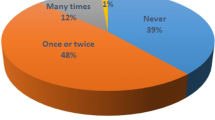Abstract
Cheating behavior of university students enrolled in an upper-division mass-lecture business course was investigated in a two-semester study. It was found that slightly over 3% of the students plagerized/copied a library research assignment. The findings indicate the need for more empirical studies of what studentsdo—as opposed to what theysay they do—when it comes to academic dishonesty in undergraduate education. Such an approach holds the greatest promise for pinpointing just how widespread cheating really is in the lecture halls and classrooms of academe.
Similar content being viewed by others
References
Baird, J. (1980). Current trends in college cheating.Psychology in the Schools 17: 515–522.
Bowers, W. J. (1964).Student Dishonesty and Its Control in College. New York: Bureau of Applied Social Research, Columbia University.
Drake, C. A. (1941). Why students cheat.Journal of Higher Education 12: 418–420.
Fass, R. A. (1986). By honor bound: Encouraging academic honesty.Educational Record 67: 32–35.
Haines, V., Diekhoff, G., LaBeff, E., and Clark, R. (1986). College cheating: Immaturity, lack of commitment, and the neutralizing attitude.Research in Higher Education 25: 342–354.
Hetherington, E., and Feldman, S. (1964). College cheating as a function of subject and situational variables.Journal of Educational Psychology 55: 212–218.
Karlins, M., and Hargis, E. (1988). Inaccurate self-perception as a limiting factor in managerial effectiveness.Perceptual and Motor Skills 66:665–666.
Kurre, J., and Tauber, R. (1987). An alternative to multiple exam versions for deterring cheating.Journal of Education for Business 62: 297–299.
Liska, A. (1978). Deviant involvement, associations, and attitudes: Specifying the underlying causal structures.Sociology and Social Research 63: 73–88.
Ludeman, R. (1988). A survey of academic integrity practices in U.S. higher education.Journal of College Student Development 29: 172–173.
Miller, G. (1988). Curbing student dishonesty.The Education Digest 53: 42–45.
Nelson, T., and Schaeffer, N. (1986). Cheating among college students estimated with the randomized-response technique.College Student Journal 20: 321–325.
Raffetto, W. (1985). The cheat.Community Technical and Junior College Journal 56: 26–27.
Scheers, N., and Dayton, C. M. (1987). Improved estimation of academic cheating behavior using the randomized response technique.Research in Higher Education 26: 61–69.
Singhal, A. (1982). Factors in student dishonesty.Psychological Reports 51: 775–780.
Stannard, C., and Bowers, W. (1970). The college fraternity as an opportunity structure for meeting academic demands.Social Problems 17: 371–390.
Stevens, G., and Stevens, F. (1987). Ethical inclinations of tomorrow's managers revisited: How and why students cheat.Journal of Education for Business 63: 24–29.
Author information
Authors and Affiliations
Rights and permissions
About this article
Cite this article
Karlins, M., Michaels, C. & Podlogar, S. An empirical investigation of actual cheating in a large sample of undergraduates. Res High Educ 29, 359–364 (1988). https://doi.org/10.1007/BF00992776
Received:
Issue Date:
DOI: https://doi.org/10.1007/BF00992776




